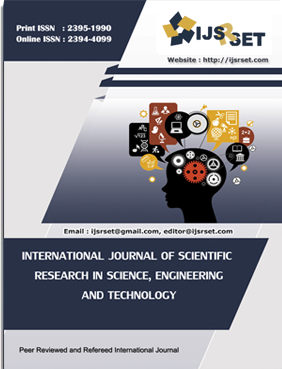Green Synthesis and Characterization of Copper Nanoparticles by Using Amaranthus Plant Extract for the Antimicrobial and Antioxidants Potential
DOI:
https://doi.org/10.32628/IJSRSET2512536Keywords:
Green synthesis, Copper nanoparticles, Amaranthus extract, Antioxidant activity, Antimicrobial potentialAbstract
The present study focuses on the eco-friendly synthesis and characterization of copper nanoparticles (CuNPs) using Amaranthus plant extract as a reducing and stabilizing agent. Phytochemicals in the extract, including flavonoids, phenols, and proteins, facilitated nanoparticle formation, confirmed by color change from blue to brown. The nanoparticles were characterized using UV–Vis spectroscopy, IR spectroscopy, particle size analysis, and zeta potential measurements. UV analysis showed a peak at 213 nm, while FTIR confirmed the presence of hydroxyl, carbonyl, and amine groups stabilizing the nanoparticles. The average particle size was 122.6 nm with a zeta potential of –0.2 mV, suggesting stability. Antioxidant activity by DPPH assay showed 91.2% inhibition at 1000 µL, close to standard ascorbic acid (93.1%). Antimicrobial assays revealed moderate activity against Streptococcus oralis, with an inhibition zone of 12 mm. The study highlights the biomedical potential of Amaranthus-mediated CuNPs as promising antioxidant and antimicrobial agents.
📊 Article Downloads
References
Woźniak-Budych MJ, Staszak K, Staszak M. Copper and Copper-Based Nanoparticles in Medicine-Perspectives and Challenges. Molecules. 2023 Sep 18;28(18):6687. DOI: https://doi.org/10.3390/molecules28186687
Thapa R.K., Kim J.O. Nanomedicine-based commercial formulations: Current developments and future prospects. J. Pharm. Investig. 2022;53:19–33. DOI: https://doi.org/10.1007/s40005-022-00607-6
Malviya R., Fuloria S., Verma S., Subramaniyan V., Sathasivam K.V., Kumarasamy V., Kumar D., Vellasamy S., Meenakshi D., Yadav S., et al. Commercial utilities and future perspective of nanomedicines. PeerJ. 2021;9:e12392. DOI: https://doi.org/10.7717/peerj.12392
Sim S., Wong N.K. Nanotechnology and its use in imaging and drug delivery (Review) Biomed. Rep. 2021;14:42. DOI: https://doi.org/10.3892/br.2021.1418
Patra J.K., Das G., Fraceto L.F., Campos E.V.R., del Pilar Rodriguez-Torres M., Acosta-Torres L.S., Diaz-Torres L.A., Grillo R., Swamy M.K., Sharma S., et al. Nano based drug delivery systems: Recent developments and future prospects. J. Nanobiotechnol. 2018;16:71. DOI: https://doi.org/10.1186/s12951-018-0392-8
Bayade G., Wu M.R., Massicotte R., Deryabin D.G.E., Yahia L.H. Biocidal properties of copper nanoparticles. Eng. Biomat. 2021;24:2–17.
De Matteis V., Rizzello L. Noble Metals and Soft Bio-Inspired Nanoparticles in Retinal Diseases Treatment: A Perspective. Cells. 2020;9:679. DOI: https://doi.org/10.3390/cells9030679
Manohar D. Kengar, Amit A. Jadhav, Suraj B. Kumbhar, Rahul P. Jadhav. A Review on Nanoparticles and its Application. Asian J. Pharm. Tech. 2019; 9(2):115-124. DOI: https://doi.org/10.5958/2231-5713.2019.00020.5
Baraniak J, Kania-Dobrowolska M. The Dual Nature of Amaranth-Functional Food and Potential Medicine. Foods. 2022 Feb 21;11(4):618. DOI: https://doi.org/10.3390/foods11040618
Karamac M., Gai F., Longato E., Meineri G., Janiak M.A., Amarowicz R., Peiretti P.G. Antioxidant activity and phenolic composition of amaranth (Amaranthus caudatus) during plant growth. Antioxidants. 2019;8:173. DOI: https://doi.org/10.3390/antiox8060173
Kulczyński B., Gramza-Michałowska A., Grdeń M. Amarantus—Wartość odżywcza i właściwości prozdrowotne. Bromat. Chem. Toksykol. 2017;1:1–7.
Szwejkowska B., Bielski S. Wartość prozdrowotna nasion szarłatu (Amaranthus cruentus L.) Postepy Fitoter. 2012;4:240–243.
Park S.J., Sharma A., Lee H.J. A review of recent studies on the antioxidant activities of a third-millennium food: Amaranthus spp. Antioxidants. 2020;9:1236. DOI: https://doi.org/10.3390/antiox9121236
Hassan, Remah A., and Zianab Tariq. 2023. "Spectrophotometric Determination of Amaranth Dye Using a Two-Step Green Cloud Point and Magnetic Solid-Phase Extraction Approach" Engineering Proceedings 59, no. 1: 244. DOI: https://doi.org/10.3390/engproc2023059244
Hassan WA, Mohammed AE, AlShaye NA, Sonbol H, Alghamdi SA, Iamonico D, Korany SM. Characterization of Amaranthus species: ability in nanoparticles fabrication and the antimicrobial activity against human pathogenic bacteria. PeerJ. 2024 Feb 8;12:e16708. DOI: https://doi.org/10.7717/peerj.16708
Antonio-Pérez A, Durán-Armenta LF, Pérez-Loredo MG, Torres-Huerta AL. Biosynthesis of Copper Nanoparticles with Medicinal Plants Extracts: From Extraction Methods to Applications. Micromachines (Basel). 2023 Sep 30;14 (10):1882. DOI: https://doi.org/10.3390/mi14101882
Qamhieh, Khawla. 2024. "Effect of Dielectric Constant on the Zeta Potential of Spherical Electric Double Layers" Molecules 29, no. 11: 2484. DOI: https://doi.org/10.3390/molecules29112484
Baliyan S, Mukherjee R, Priyadarshini A, Vibhuti A, Gupta A, Pandey RP, Chang CM. Determination of Antioxidants by DPPH Radical Scavenging Activity and Quantitative Phytochemical Analysis of Ficus religiosa. Molecules. 2022 Feb 16;27(4):1326. DOI: https://doi.org/10.3390/molecules27041326
Guo L, Wang Y, Bi X, Duo K, Sun Q, Yun X, Zhang Y, Fei P, Han J. Antimicrobial Activity and Mechanism of Action of the Amaranthus tricolor Crude Extract against Staphylococcus aureus and Potential Application in Cooked Meat. Foods. 2020 Mar 19;9(3):359. DOI: https://doi.org/10.3390/foods9030359
Downloads
Published
Issue
Section
License
Copyright (c) 2025 International Journal of Scientific Research in Science, Engineering and Technology

This work is licensed under a Creative Commons Attribution 4.0 International License.




